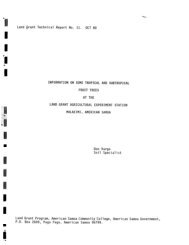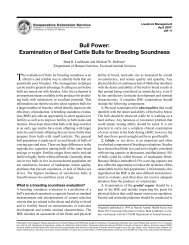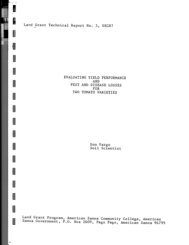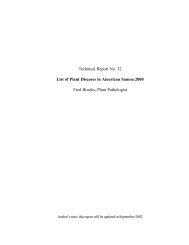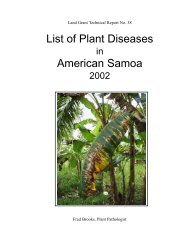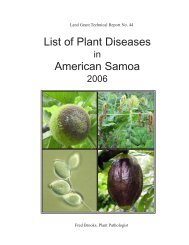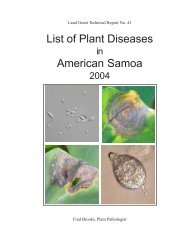Banana Bunchy Top Virus
Banana Bunchy Top Virus
Banana Bunchy Top Virus
Create successful ePaper yourself
Turn your PDF publications into a flip-book with our unique Google optimized e-Paper software.
<strong>Banana</strong> <strong>Bunchy</strong> <strong>Top</strong> <strong>Virus</strong><br />
Pests and Diseases of American Samoa<br />
Number 1<br />
American Samoa Community College<br />
Agriculture, Human & Natural Resources<br />
Cooperative Research & Extension 2000<br />
Introduction<br />
<strong>Banana</strong>s are one of the most important food crops in American<br />
Samoa and most Samoans grow them on their land. <strong>Banana</strong>s do<br />
not hold the same place in traditional Samoan culture as taro but<br />
they are still a mains source of carbohydrate in the diet. <strong>Banana</strong>s<br />
are not an export crop but consumed locally. They are either baked,<br />
boiled or fried when still green, or eaten ripe.<br />
<strong>Banana</strong> <strong>Bunchy</strong> <strong>Top</strong> <strong>Virus</strong> (BBTV) is one of the most important<br />
diseases of banana. It is caused by a virus and carried over short<br />
distances by the banana aphid. Long and short distance spread is by<br />
infected pieces of the mat (rhizome), transplanted suckers, or virusinfected<br />
tissue culture plants. BBTV was first recorded in Fiji in<br />
1889, where it caused serious damage. It arrived in Samoa in the late<br />
1950s and in American Samoa shortly after.<br />
Symptoms<br />
Infected plants are dwarfed and their emerging leaves small and<br />
narrow with brittle, yellow edges. The leaves grow upright and<br />
have a stunted, bunched appearance (Fig. 1).<br />
Fig. 2. Suckers growing from a mat infected with BBTV.<br />
Fig. 1. Sucker with symptoms of <strong>Banana</strong> <strong>Bunchy</strong> <strong>Top</strong> <strong>Virus</strong>.<br />
Mature plants infected with the disease usually do not produce<br />
fruit, or the fruit may not emerge from the stem. The virus eventually<br />
infects the whole mat and banana production is permanently<br />
lost (Fig. 2).<br />
A campaign by the American Samoa Community College Land<br />
Grant Program (Land Grant) Extension Service from 1996 to early<br />
1998 put the problem before the people of American Samoa. Public<br />
awareness was raised and a few farmers now control BBTV on<br />
their land. There is a <strong>Bunchy</strong> <strong>Top</strong> Law (American Samoa<br />
Government Administrative Code 24.04) that places responsibility<br />
for eradication of BBTV on occupiers of the land, but it is not<br />
usually enforced.<br />
In March 1999, Land Grant and the American Samoa Department<br />
of Agriculture conducted a BBTV survey of the Territory. Over<br />
30,000 banana mats were evaluated in 20 villages and 10<br />
commercial farms on the main island of Tutuila; 10,000 mats were<br />
counted on the islands of Ofu, Olosega, Ta’u and Aunu’u. The<br />
average number of mats infected with BBTV on Tutuila was less<br />
than 5% in villages and just over 5% on the 10 commercial farms<br />
and Aunu’u; no BBTV was found on Ofu, Olosega or Ta’u. Several<br />
factors may have led to low percentages of BBTV in American<br />
Samoa. First, there is a period of up to 125 days between the time<br />
a virus-carrying aphid infects a plant and when the plant begins to<br />
show symptoms of the disease. These plants and others with early,<br />
mild symptoms were not counted in the survey. Second, in many<br />
areas dense undergrowth on unkempt farms may have hidden<br />
infected suckers from the surveyors. Also, mats recently killed by<br />
the disease were not counted. Finally, Samoans traditionally cut<br />
down plant stems with symptoms of BBTV in an effort to control<br />
the disease. This practice was probably a major reason for the<br />
low number of infected mats counted.<br />
Published by the division of Agriculture, Human and Natural Resources, American Samoa Community College, and issued in furtherance of Cooperative Extension<br />
Work Acts of May 8 and June 30, 1914, in cooperation with the U.S. Department of Agriculture Cooperative Extension Service. Carol Whitaker, Director, Cooperative<br />
Extension Service, AHNR, American Samoa Community College at Pago Pago, American Samoa 96799. The American Samoa Community College division of<br />
Agriculture, Human and Natural Resources prohibits discrimination in all its programs and activities on the basis of race, color, national origin, gender, religion, age,<br />
disability, political beliefs, sexual orientation, and marital or family status.
Control<br />
There are no known banana varieties resistant to BBTV and no<br />
chemicals to control it. Programs aimed at controlling the disease<br />
by managing the aphid population have been unsuccessful. Plant<br />
quarantine, while essential, is notoriously difficult to enforce.<br />
Cutting down virus-infected mats with a bush knife is ineffective;<br />
the virus is also in the mat and emerging suckers will be infected.<br />
Once introduced, BBTV has never been eradicated from a country.<br />
The disease is at a relatively low level in American Samoa and<br />
for unknown reasons is moving slowly, compared to other<br />
countries: parts of Australia, India, Pakistan and Samoa were<br />
devastated by BBTV in the past. If left untreated, however, the<br />
cumulative effects of BBTV in American Samoa could be severe.<br />
In early 1999, Hawai’i Department of Agriculture reported<br />
eradication of BBTV on Kauai following the destruction of all<br />
banana plants in a one square mile area of infection. Roundup<br />
Ultra® (glyphosate) played a key role in these results (Fig 3).<br />
4. Spray 1 ml (one squirt from a spray bottle) of concentrated<br />
Roundup Ultra® into the hole in the plant stem; if the stem<br />
diameter is greater than 3 inches, spray 2 ml into the hole.<br />
Wear safety glasses, rubber gloves, long-sleeved shirts, long<br />
pants and close-toed shoes.<br />
5. For very small plants and suckers, make a hole down through<br />
the top and spray once into the hole.<br />
6. Never spray more than 15 ml (15 squirts) into any one mat.<br />
7. Check treated mats every two weeks and kill any new growth<br />
with the same method; also check surrounding mats for<br />
symptoms of the disease (Fig. 4).<br />
8. Never harvest or eat bananas from treated mats.<br />
Replanting<br />
It is important to replace treated mats with plants free from the<br />
virus. If treated mats are replaced with suckers or ‘bits’ from the<br />
field, the material should be selected from an area free of BBTV.<br />
After planting, check new mats routinely for virus symptoms.<br />
Fig. 4. <strong>Banana</strong> mat killed with glyphosate injections.<br />
Fig. 3. BBTV-infected mat injected with glyphosate.<br />
Roundup Ultra® has recently been registered for use in American<br />
Samoa to destroy banana plants infected with <strong>Banana</strong> <strong>Bunchy</strong> <strong>Top</strong><br />
<strong>Virus</strong> (EPA Reg. No. 524-475). It is the center of a new Land<br />
Grant campaign to greatly reduce the amount of BBTV in the<br />
Territory.<br />
The following steps are recommended by the Land Grant Extension<br />
Service for the destruction of BBTV-infected plants by homeowners<br />
and commercial growers.<br />
1. Remove any banana bunches growing on infected mats before<br />
treatment.<br />
2. Spray aphids with soapy water (1 tbsp. liquid dish soap/gallon<br />
water), Safer Soap® or kerosene; the insects are mostly found<br />
on suckers and where leaves meet stems.<br />
3. Make a hole at least one foot above the ground in every stem<br />
of the infected mat; use a screwdriver or other sharp object.<br />
Our thanks to Guy Nagai, Eloise Killgore and Nilton<br />
Matayoshi, Hawai’i Department of Agriculture, for their<br />
generous assistance with the BBTV control program. We also<br />
thank American Samoa Department of Agriculture and members<br />
of American Samoa Community College Land Grant Program<br />
divisions of forestry, extension, 4-H and research for help with<br />
the BBTV survey.<br />
This work was partially funded by a grant from USDA<br />
Cooperative State Research, Extension, and Education Service<br />
(CSREES) Pesticide Impact Assessment Program (PIAP).<br />
For further information on recognizing or controlling <strong>Banana</strong><br />
<strong>Bunchy</strong> <strong>Top</strong> <strong>Virus</strong>, please contact: American Samoa Comunity<br />
College Land Grant Extension Service; tel. 684-699-1394;<br />
fax 684-699-5011.<br />
Brochure prepared by Fred Brooks, Plant Pathologist, AHNR.



